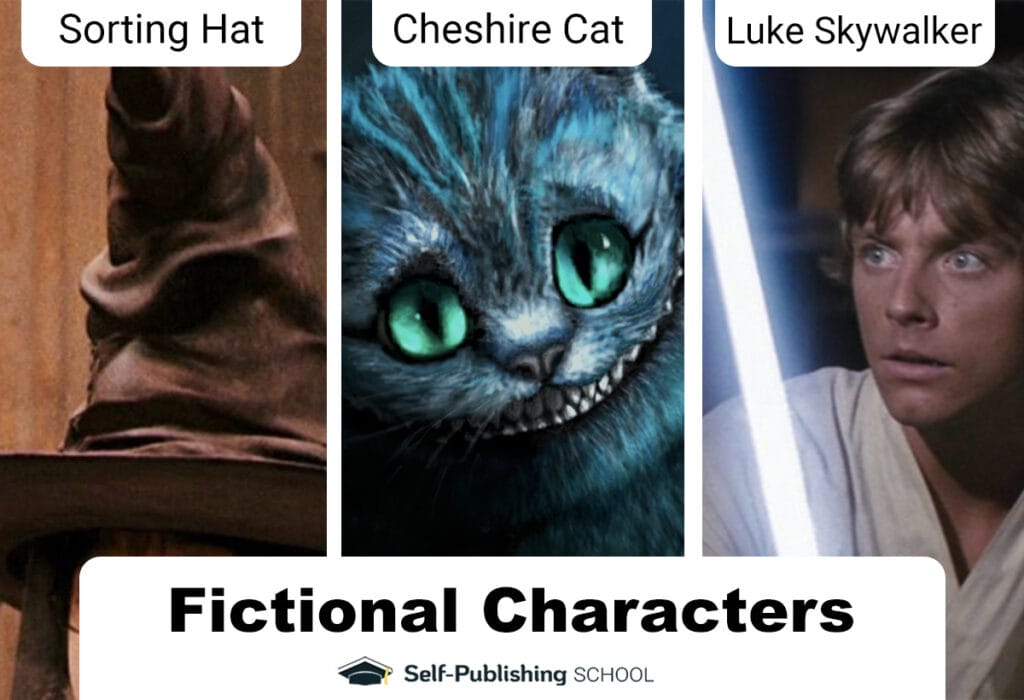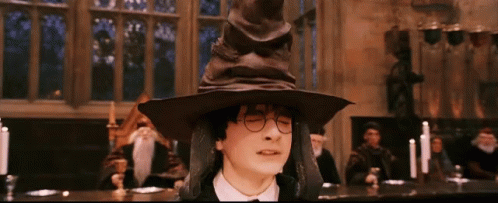Not every story has a fictional character, but the large majority do. There’s a reason for that. There’s a reason that aside from nursery rhymes, there aren’t a ton of books about only animals. Or only plants.
Even in these cases, you could argue that fictional characters don’t have to just be people.
Because of the ins-and-outs of storytelling, the job of a fictional character can be misunderstood. So I’m going to crack open all that is a fictional character and do some sorting of the insides.
That sentence might sound horrifying if your idea of a fictional character was so narrow as to imagine a person, when in fact, the character in this metaphor just so happens to be a pumpkin named Grigo. No worries. I hope to fix those preconceived notions in this post!
Here’s what you’ll learn about fictional characters:
- What is a fictional character?
- The Importance of Fictional Characters
- 20 Examples of Fictional Characters
- Elements of a Fictional Character
What is a fictional character?
Any person, animal, plant, or other personified element that interacts within a story is a fictional character. They’re not real, but can be created based on real traits and characteristics to fulfill the purpose of telling a specific story.
Commonly, most people think of fictional characters as made-up people, which is true in most cases. The more lifelike the fictional character, the better they can tell the story because readers will want them to continue until the end of it. Good characters, that is.
But characters serve many more purposes than just being the people in a story.

The Importance of a Fictional Character
Your worldbuilding can be incredible and your plot can be gripping, but if you have bad fictional characters, you’ll have a hard time getting readers to consume your books. Most often, especially with book series, readers want to revisit the characters as much as they’re curious about the plot you set up.
And that’s just one of the reasons they’re important.
- Driving the Plot: Characters are the agents of change within a story. Their decisions and actions propel the plot forward. Without a character to make a decision, there isn’t a change in conflict. How you shape the fictional character is how they’ll respond to certain conflict in the plot. That’s what makes a story unique.
- Eliciting Empathy and Identification: Well-crafted characters evoke emotions and allow readers to empathize with their struggles, victories, and failures. This emotional connection fosters a deeper engagement with the story.
- Exploring Themes and Ideas: Characters often embody larger themes or ideas within a story. Through their experiences, authors can address complex issues, provide social commentary, or explore philosophical concepts.
- Entertainment and Escapism: Characters captivate readers, drawing them into fantastical worlds and providing an escape from reality. They create a bridge between the reader and the fictional universe, allowing for immersion in the narrative.
- Perspective and the Story’s Angle: The character you use to tell the story can make a huge difference in how the story is told, and therefore perceived. This is more about the main character, but it’s still important for side characters too. Take a story you really like. Now imagine if the story was told from another character’s perspective. How different would the theme be? How skewed would the angle be?
The fictional characters become the lenses through which we see a story taking place. Never forget that!
34 Examples of Fictional Characters Who Ruled Their Stories
Most writers think of characters as people. And that’s probably because they mostly pay attention to people, or people are the primary element moving the story forward (again, unless it’s a children’s story).
But I’m here to get your mind thinking about something other than your preconceived notions about what a fictional character actually is—because it’s not always people.
You’ll see more examples of this below, but we’ll start with common people fictional characters.
Here are some people-specific fictional characters:
- Harry Potter in the Harry Potter series by J.K. Rowling
- Sherlock Holmes in Sherlock Holmes series by Arthur Conan Doyle
- Frodo Baggins in The Lord of the Rings series by J.R.R. Tolkien
- Katniss Everdeen in The Hunger Games series by Suzanne Collins
- Atticus Finch in To Kill a Mockingbird by Harper Lee
- Luke Skywalker in the Star Wars franchise
- Hermione Granger in the Harry Potter series by J.K. Rowling
- James Bond in the James Bond series by Ian Fleming
- Superman in DC Comics
- Wonder Woman in DC Comics
- Spider-Man in the Marvel Comics
- Elizabeth Bennet in Pride and Prejudice by Jane Austen
- Frodo Baggins in The Lord of the Rings series by J.R.R. Tolkien
- Aragorn in The Lord of the Rings series by J.R.R. Tolkien
- Captain Jack Sparrow in Pirates of the Caribbean film series
- Darth Vader in the Star Wars franchise
- Hermione Granger in the Harry Potter series by J.K. Rowling
- Batman in DC Comics
- James T. Kirk in the Star Trek franchise
- Lara Croft in the Tomb Raider video game series
Here are non-people fictional characters you may know of:
- Fawkes in the Harry Potter series – Fawkes is a phoenix, a magical bird that serves as a loyal companion to Albus Dumbledore. Fawkes has the ability to be reborn from its ashes.
- Aslan in The Chronicles of Narnia series – Aslan is a powerful and wise lion who serves as the ultimate force of good and creator of the world of Narnia.
- The One Ring in The Lord of the Rings series – The One Ring is a powerful and malevolent object with a will of its own. It plays a central role in the story’s conflict.
- Buckbeak in the Harry Potter series – Buckbeak is a Hippogriff, a magical creature with the body of a horse and the wings and head of an eagle. He forms a bond with Harry Potter.
- The White Rabbit in Alice’s Adventures in Wonderland – The White Rabbit is a key character who leads Alice into Wonderland by rushing down a rabbit hole.
- The Ents in The Lord of the Rings series – Ents are ancient, tree-like creatures that inhabit the forests of Middle-earth. They play a vital role in the battle against Sauron.
- The Sorting Hat in the Harry Potter series – The Sorting Hat is a magical hat that determines which of the four Hogwarts houses a student belongs to.
- The Whomping Willow in the Harry Potter series – The Whomping Willow is a magical tree on the Hogwarts grounds that is known for its aggressive and violent tendencies.
- The Great White Shark in Jaws – In the film “Jaws,” the shark is a relentless force of nature that terrorizes a coastal town.
- The Oracle of Delphi in Greek mythology – The Oracle of Delphi was a priestess who served as a medium for the god Apollo. She provided prophecies and advice.
- The Cheshire Cat in Alice’s Adventures in Wonderland – The Cheshire Cat is a mischievous character who can appear and disappear at will and offers cryptic advice to Alice.
- The Flying Nimbus in the Dragon Ball series – The Flying Nimbus is a magical cloud that Goku and other characters in the Dragon Ball series use for transportation.
- The Balrog in The Lord of the Rings series – The Balrog is a fearsome, fire-breathing creature that Gandalf confronts in the Mines of Moria.
- The Basilisk in Harry Potter and the Chamber of Secrets – The Basilisk is a serpent-like creature that poses a deadly threat in the second book of the Harry Potter series.

Some of the examples here might not seem like characters, but they are! They serve the same purpose and have the same elements. Ultimately, they’re used to the same ends in fiction stories and therefore can be considered characters.
But let’s go deeper into the elements so you understand what I mean.
Elements of a Fictional Character to Develop With Care
You’ve gotta have these! Maybe not for every single character you create. A passing scribe in a medieval fantasy series isn’t necessary to use these for, so long as they’re not plot important.
Any plot-important fictional character should have some of these known. The more screen-time a character gets, the deeper and more thought out these should be. This is good character development as a whole.
- Personality Traits: Every fictional character possesses a unique set of personality traits that define their behavior, beliefs, and emotional responses. These traits serve as the character’s psychological DNA, shaping their interactions and decisions throughout the story. This should be based off their backstory, too. Someone who’s had a lot of trauma will show it in different ways, and this impacts their overall personality as well as their character flaws and weaknesses.
- Motivations and Goals: Just like real people, fictional characters have desires and aspirations that drive their actions. Their character motivations are what drive them forward—what causes them to make certain decision and take certain actions. These motivations provide the character with purpose and direction, but they can also get them in trouble.
- Backstory: A character’s backstory encompasses their history, experiences, and circumstances prior to the events of the story. This element adds depth and complexity, allowing readers to understand the character’s past and how it informs their present behavior. Usually, the backstory shapes the character, their personalities, their flaws, and their worldview.
- Conflict and Growth: Characters often face challenges or conflicts that force them to evolve and grow. This transformation is a pivotal aspect of character development, providing a sense of realism and relatability to the reader. The character arc happens as a result of the fictional character making certain decisions and actions that allow them to overcome their weaknesses to accomplish their goals.
- Dialogue and Voice: The way a character speaks, the words they choose, and their unique idiosyncrasies all contribute to their distinct voice. This aspect of characterization helps readers differentiate between characters and establishes a connection with their individual personas. Brandon Sanderson, one of the biggest fantasy authors right now, says that as a writer, you should be able to write dialogue without tags or labels and the reader should be able to point out who is who. Of course, this happens after they’ve gotten to know the characters a bit. But the idea is simple: nobody speaks the same, with the same syntax, word choice, volume, or habits. Fictional characters should vary in this.
Fictional characters are more than people realize in a story. But they’re also not everything you need to write a quality novel. To learn more about that process in detail, check out this 1-hour class teaching the process:
